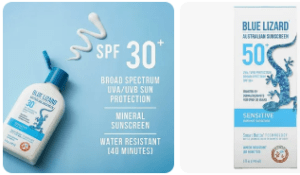We often receive inquiries about various sunscreens, including our products. We’re always happy to provide an honest assessment of any skincare item. To address questions about other brands, we start by examining their ingredients. Then, we weigh the pros and cons of each component to give a well-informed opinion.
A brand we frequently get asked about is Blue Lizard. So, is Blue Lizard sunscreen reef safe? Let’s delve into it.
Step 1: Choose a Blue Lizard Sunscreen to Investigate
We selected Amazon’s Choice: Blue Lizard Active Mineral-Based Sunscreen Lotion SPF 50. Here’s Blue Lizard’s reef-safe marketing message:
“We Love the Reef – To help protect delicate coral reefs, our Active sunscreen contains no Oxybenzone or Octinoxate.”
“Blue Lizard’s We Love the Reef sunscreens are Oxybenzone free and Octinoxate free for a swimming sunscreen that has delicate coral reefs in mind.”
Step 2: Research Ingredients for Blue Lizard
- Active Ingredients (per their website):
Octisalate – 5%
Titanium Dioxide – 5.4%
Zinc Oxide – 10%
- Inactive Ingredients (per their website):
Alumina, Aluminum Stearate, Beeswax, Butyloctyl Salicylate, C12-15 Alkyl Benzoate, Caprylic/Capric Triglyceride, Caprylyl Glycol, Cetyl Dimethicone, Cetyl PEG/PPG-10/1 Dimethicone, Diisopropyl Sebacate, Dimethicone, Disodium EDTA, Ethylhexylglycerin, Hexyl Laurate, Hydrogenated Castor Oil, Isostearyl Isostearate, L-Arginine, Methyl Glucose Dioleate, Methylpropanediol, Octyldodecyl Neopentanoate, PEG-7 Hydrogenated Castor Oil, Phenoxyethanol, Phenylpropanol, Polygylceryl-4 Isostearate, Polyhydroxystearic Acid, Polyurethane-35, Propanediol, Purified Water, Sorbitan Oleate, Stearic Acid, Tocopheryl Acetate, Triethoxycaprylylsilane, Trimethylsiloxysilicate, VP/Hexadecene Copolymer
Step 3: Analyze the Active Ingredients
Octisalate
A chemical sunscreen ingredient, octisalate at 5% is the maximum allowed by the FDA. It enhances UVB protection but degrades in sunlight and acts as a penetration enhancer, allowing more substances to enter the skin and bloodstream. Octisalate is harmful to marine life.
Titanium Dioxide
While effective at providing sun protection, titanium dioxide contains titanium, a heavy metal that can generate free radicals, accelerating skin aging and causing oxidative damage. Nano-sized titanium dioxide can cause coral bleaching. As Blue Lizard doesn’t specify “non-nano” particles, we assume it uses nano-sized particles, making it unsafe for reefs.
Zinc Oxide
For zinc oxide to be reef-safe, it must be non-nano. Nano-sized particles are harmful to marine life, causing coral bleaching and other damage. Blue Lizard does not indicate that their zinc oxide is non-nano, suggesting it may not be reef-safe.
Step 4: Final Verdict: Is Blue Lizard Sunscreen Reef Safe?
Based on the ingredient analysis, Blue Lizard Active Mineral-Based Sunscreen Lotion SPF 50 is not reef-safe. The term “reef safe” is unregulated, and the Hawaii ban on oxybenzone and octinoxate has led to the misconception that products free of these ingredients are automatically reef-safe. Brands like Blue Lizard exploit this misunderstanding, prioritizing market perception over true reef safety.
Bonus: What Does Reef Safe Mean?
The term “reef safe” is increasingly used on sunscreen labels to attract eco-conscious consumers. However, this term is not regulated by the FDA and is often misleading. Most sunscreens labeled as “reef safe” still contain ingredients harmful to marine ecosystems.
| Feature | Benefit |
| Mineral Filters (Zinc Oxide) | Gentle on sensitive skin, reduces irritation |
| Broad Spectrum SPF 30+ & 50+ | Protects against UVA & UVB rays (up to 97%) |
| Variety of Formulas | Options for sensitive skin, oily skin, and facial use (with moisturizer) |
| Water Resistant & Smart Bottle Technology | Maintains protection after sweating/swimming, reminds you to reapply |
To be genuinely reef-safe, sunscreen must:
- Contain only mineral active ingredients (zinc oxide or titanium dioxide).
- Use non-nano versions of these minerals, ensuring particle sizes are large enough not to harm marine life.
Non-nano zinc Oxide Sunscreen is reef-safe
Non-nano zinc oxide is the safest sunscreen ingredient for both humans and marine ecosystems. It doesn’t dissolve in seawater and settles to the seafloor, becoming part of the sediment without causing harm. In contrast, nano zinc oxide can damage marine animals and coral, generating toxic hydrogen peroxide when exposed to UV rays.
Know Your Sunscreen. Trust Your Sunscreen.
Always read and research sunscreen ingredients. Understanding each component helps determine if a product is genuinely reef-safe. If in doubt, ask us for guidance. We aim to provide straightforward advice, whether about our products or others.
Use Non-Nano Zinc Oxide Sunscreen
Our travel-friendly, pocket-sized field tins offer the thickest, toughest, healthiest, and most reef-friendly sunscreen available, staying on through saltwater, pool water, and sweat to protect and nourish your skin.


